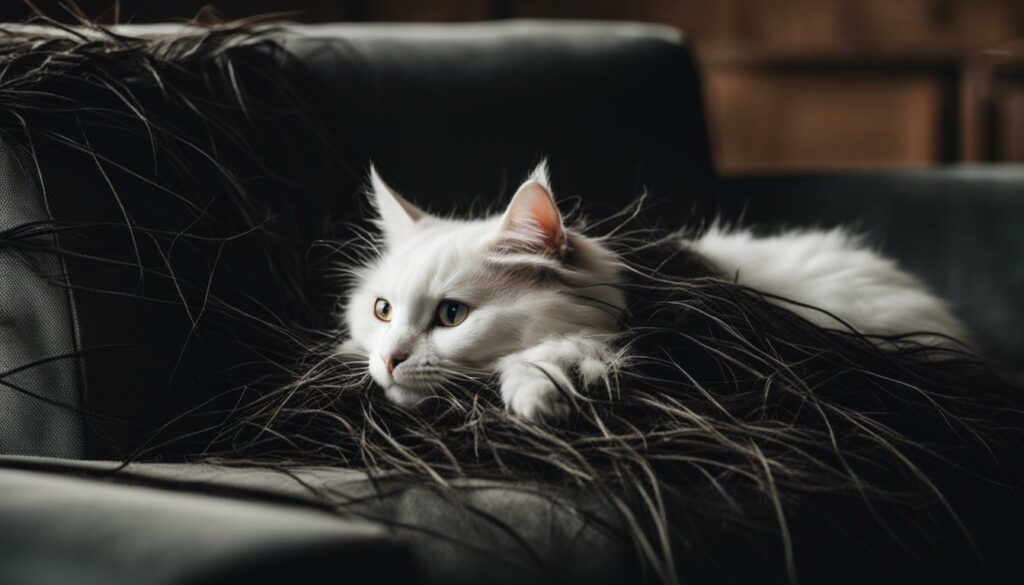Having a cat can be a wonderful experience, but it’s important to consider the reasons why someone might choose not to get a cat. Cat allergies, the maintenance of cat hair and litter boxes, the long-term commitment and responsibility of pet ownership, travel restrictions, challenges of cat ownership in an apartment living situation, the time commitment involved in caring for a cat, and the cost of care including vet visits and other expenses are all factors to consider.
While these may be valid reasons for some individuals, it’s important to make an informed decision that best suits your circumstances. Let’s explore these factors in more detail to help you determine if getting a cat is the right choice for you.
Key Takeaways
- Cat allergies, the maintenance of cat hair and litter boxes, and the long-term commitment are important factors to consider.
- Travel restrictions, challenges in apartment living, and the time commitment involved in caring for a cat are also significant considerations.
- The cost of care, including vet visits and other expenses, should be taken into account.
- Understanding cat behavior and the benefits of cat ownership can help inform your decision.
- Ultimately, the decision to not get a cat should be based on your personal circumstances and preferences.
Finding the Right Cat for Your Lifestyle
When it comes to getting a cat, finding the right one for your lifestyle is crucial. Each cat has its own unique behavior and personality, and it’s important to consider their individual needs when making a choice. Whether you prefer a more independent cat or one that craves constant attention, understanding the different types of cat personalities can help you make the best decision.
Understanding Cat Behavior
Cat behavior plays a significant role in finding the right cat for your lifestyle. Some cats are more territorial and may guard their space, while others have strong hunting instincts and enjoy interactive play. Additionally, considering their activity levels and whether they are more active during the day or night can help you determine if their behavior aligns with your schedule.
Grooming is another aspect to consider. Some cats have shorter hair that requires minimal grooming, while others have long hair that needs regular brushing to prevent matting and excessive shedding. Understanding the grooming needs of different cat breeds can help you choose the one that suits your preference and lifestyle.
Providing a Suitable Environment
Creating a suitable environment for your cat is essential for their overall well-being. Cats need space to explore, play, and relax. Providing them with scratching posts, climbing structures, and toys can help satisfy their natural instincts and keep them mentally and physically stimulated.
It’s also important to consider if you have a safe and secure space for your cat, especially if you live in a busy area or near a road. Indoor cats may require additional attention and enrichment to ensure they have enough exercise and mental stimulation.
| Factors to Consider | Considerations |
|---|---|
| Grooming Needs | Some cats require regular brushing and grooming, while others have lower maintenance coats. |
| Activity Level | Different cats have different activity levels. Consider how active or relaxed you want your cat to be. |
| Indoor vs. Outdoor | Decide if your cat will be an indoor-only cat or have access to the outdoors. |
| Living Space | Make sure you have enough space for your chosen cat breed, considering their size and play needs. |
Ultimately, finding the right cat for your lifestyle requires careful consideration of their behavior, grooming needs, and the environment you can provide. By taking these factors into account, you can ensure a harmonious and fulfilling relationship with your feline companion.
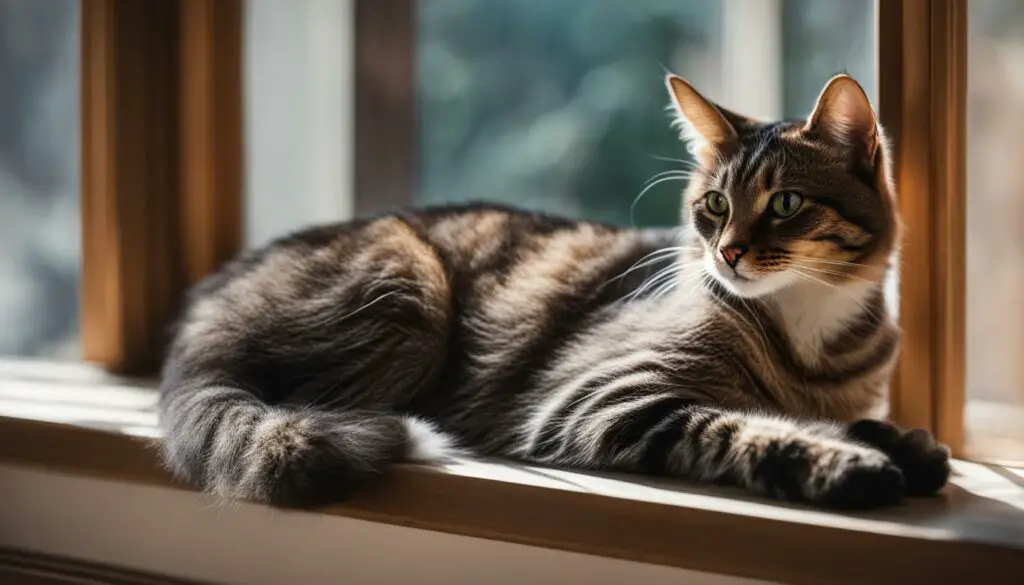
Time Commitment and Pet Maintenance
When deciding whether to get a cat, it’s important to consider the time commitment and pet maintenance required. Owning a cat involves a daily care routine that includes feeding, cleaning, grooming, and providing play and exercise. These activities are crucial for the health and well-being of your feline companion.
Feeding your cat on a consistent schedule is essential. Cats have specific dietary needs, and it’s important to provide them with a balanced and nutritious diet. You’ll need to make time for regular meal preparation and ensure your cat has access to fresh water at all times.
Cleaning is another important aspect of cat ownership. You’ll need to regularly clean and maintain your cat’s litter box to ensure proper hygiene and prevent unpleasant odors. Additionally, grooming your cat, including brushing their coat and trimming their nails, will help keep them clean and reduce shedding.
| Task | Frequency |
|---|---|
| Feeding | Twice daily |
| Cleaning the litter box | Daily |
| Grooming | Regularly (depends on the breed) |
| Play and exercise | Daily |
Play and exercise are essential for a cat’s physical and mental well-being. Cats need regular opportunities to engage in interactive play and exercise to prevent boredom and maintain a healthy weight. This can include playing with toys, providing scratching posts, and engaging in interactive play sessions with your cat.
It’s important to evaluate whether you have the time and commitment to incorporate these tasks into your daily routine. Cats thrive on routine and consistency, and it’s crucial to provide them with the care and attention they need to lead happy and healthy lives.
Allergies and Cat Hair
When it comes to owning a cat, allergies can be a significant concern for some individuals. Cat allergies are typically triggered by cat hair, shedding, and dander, which can lead to allergic reactions in sensitive individuals. Common allergy symptoms include itching, sneezing, watery eyes, and difficulty breathing. It’s crucial to consider whether you or someone in your household has allergies before deciding to bring a cat into your home.
Cat hair and dander can easily spread throughout the house, making it important to take precautions to minimize exposure. Regularly vacuuming, dusting, and keeping the cat out of certain areas, such as bedrooms, can help reduce allergens in the environment. Additionally, grooming your cat regularly can help minimize shedding and dander. However, it’s important to note that even hypoallergenic cat breeds can still produce allergens.
Managing Cat Allergies
If you or a family member have allergies but still want to have a cat, there are several strategies you can consider to manage cat allergies:
- Medications: Over-the-counter antihistamines and nasal sprays can help alleviate allergy symptoms. Consult with a healthcare professional for appropriate recommendations.
- Allergy Shots: Allergy shots, also known as immunotherapy, can be effective in reducing sensitivity to cat allergens over time. This involves receiving regular injections of a small amount of the allergen to desensitize the immune system.
- Air Purifiers: Using HEPA air purifiers can help filter out allergens from the air, reducing the overall allergen load in your living space.
- Regular Cleaning: Keeping your home clean and free from cat hair and dander is crucial. Regularly dust, vacuum, and launder bedding to minimize allergen exposure.
- Designated Cat-Free Zones: Creating specific areas in your home where the cat is not allowed, such as bedrooms or certain furniture, can help reduce the amount of allergens in those spaces.
By taking these measures, it may be possible to minimize the impact of cat allergies and still enjoy the companionship of a feline friend. However, it’s important to note that individual experiences with cat allergies can vary, and it’s essential to consult with a healthcare professional for personalized advice and guidance.

| Allergy Symptoms | Prevention Strategies |
|---|---|
| Itching, sneezing, and watery eyes | Regularly vacuum and dust, keep the cat out of bedrooms, groom the cat regularly |
| Difficulty breathing | Use HEPA air purifiers, consider allergy shots, consult with a healthcare professional for appropriate medications |
Litter Box Maintenance
Proper litter box maintenance is crucial for the health and well-being of your cat. It ensures a clean and odor-free environment for both you and your furry friend. Here are some essential tips on litter box cleaning, odor control, litter options, and proper disposal.
Cleaning: Scooping the litter box daily is essential to remove waste and keep the box clean. This helps prevent odor buildup and keeps your cat’s paws clean. Additionally, you should fully clean the litter box at least once a week by completely emptying the litter, washing the box with mild detergent, and adding fresh litter.
Odor Control: Using odor control litter or adding baking soda to the litter can help minimize unpleasant smells. Scooping regularly and fully cleaning the box will also contribute to odor control.
| Litter Options | Advantages | Disadvantages |
|---|---|---|
| Scoopable Litter | – Easy to clean – Controls odor – Lasts longer |
– More expensive – May track outside the box |
| Clay-based Litter | – Affordable – Absorbs moisture well |
– Needs frequent changing – Can be dusty – Not eco-friendly |
| Recycled Paper Litter | – Environmentally friendly – Low dust |
– Less effective odor control – May need more frequent changing |
Disposal: When disposing of used litter, it is essential to seal it in a plastic bag before placing it in the trash. Avoid flushing litter down the toilet, as it can cause plumbing issues and harm the environment.
Remember, cats are naturally clean animals, and providing them with a well-maintained litter box contributes to their overall happiness and comfort.
Commitment and Long-Term Care
When deciding to bring a cat into your life, it’s essential to recognize that it is a long-term commitment. Cats can live for 15 years or longer, and as a responsible owner, you need to be prepared to provide care and attention throughout their entire life. This includes their senior years and the aging process, where they may require additional support and specialized care.
Senior cat care involves monitoring their health closely and making necessary adjustments to their diet, exercise routine, and living environment. Older cats may experience age-related conditions such as arthritis, dental issues, or cognitive decline, and they may need regular veterinary check-ups and treatments to manage these conditions effectively. By being aware of their changing needs and providing the appropriate care, you can ensure that your cat enjoys a comfortable and fulfilling life as they age.
Senior Cat Care Checklist
- Regular veterinary check-ups and vaccinations
- Monitoring food intake and adjusting diet as needed
- Providing a comfortable and safe living environment
- Regular grooming to maintain coat health and manage any skin conditions
- Keeping an eye out for signs of pain or discomfort
- Encouraging mental and physical stimulation through interactive toys and play
- Providing a quiet and calm space for relaxation
By investing time, effort, and resources into the long-term care of your cat, you can ensure they live a happy and healthy life. Remember, adopting a cat is not just a short-term commitment but a commitment to be there for them throughout their entire journey.
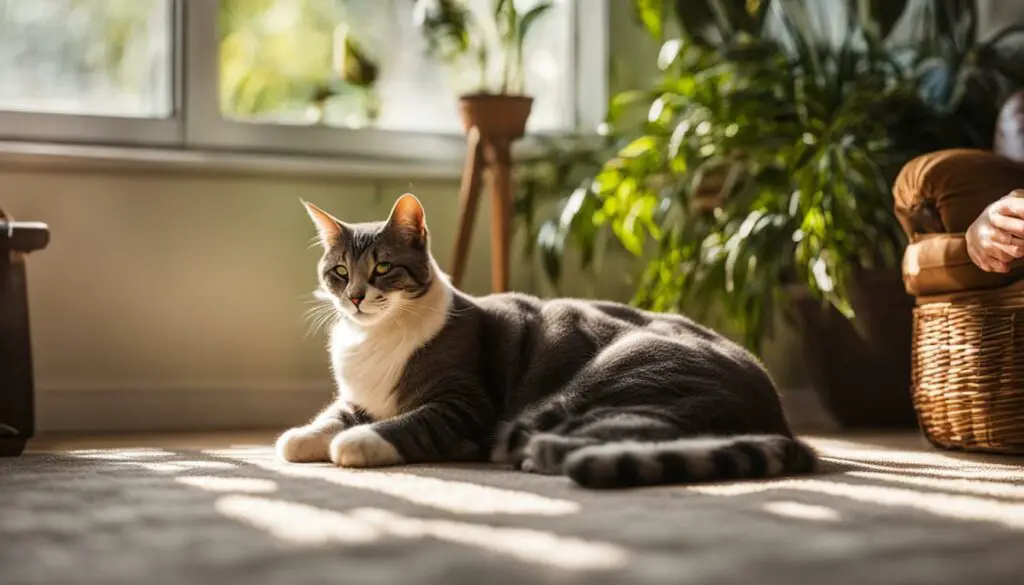
| Age Group | Average Lifespan | Considerations |
|---|---|---|
| Kitten | 0-1 year | Focus on socialization, basic training, and vaccinations. |
| Adult | 1-10 years | Maintain regular veterinary check-ups, monitor diet, and provide mental and physical stimulation. |
| Senior | 10+ years | Increased veterinary care, potential age-related health issues, and specialized senior cat care. |
Travel Restrictions
When considering getting a cat, it’s important to take into account travel restrictions and the need for appropriate pet care arrangements. Unlike dogs, cats can be more difficult to accommodate during travel, which can pose challenges for cat owners. Before planning a trip, it’s essential to have arrangements in place for the care of your cat.
One option is boarding your cat at a trusted pet boarding facility. These facilities provide a safe and secure environment for your cat while you’re away. They typically offer services such as feeding, playtime, and adequate space for your cat to move around. Boarding facilities also have trained staff who can monitor your cat’s health and address any medical needs if required.
Another option is hiring a pet sitter who can come to your home to care for your cat. This allows your cat to remain in a familiar environment and reduces the stress of being in a new location. A pet sitter can provide feeding, litter box cleaning, playtime, and companionship for your cat while you’re away.
Quotes:
Absence from home is always difficult when you have a beloved furry friend, but with proper planning and arrangements, you can ensure that your cat is well-cared for and safe during your travels.
Table:
| Pet Care Arrangements | Pros | Cons |
|---|---|---|
| Boarding Facility | – Safe and secure environment | – May be costly |
| Pet Sitter | – Allows your cat to stay in a familiar environment | – Requires entrusting your home to someone |
Cats may also experience separation anxiety when their owners are away, which should be taken into account when planning for travel. It’s important to create a comforting environment for your cat, providing familiar toys, blankets, and bedding. Additionally, leaving a piece of clothing with your scent can help alleviate anxiety and provide reassurance for your cat.
By considering travel restrictions and making appropriate pet care arrangements, you can ensure that both you and your cat have a stress-free experience during your time away from home.
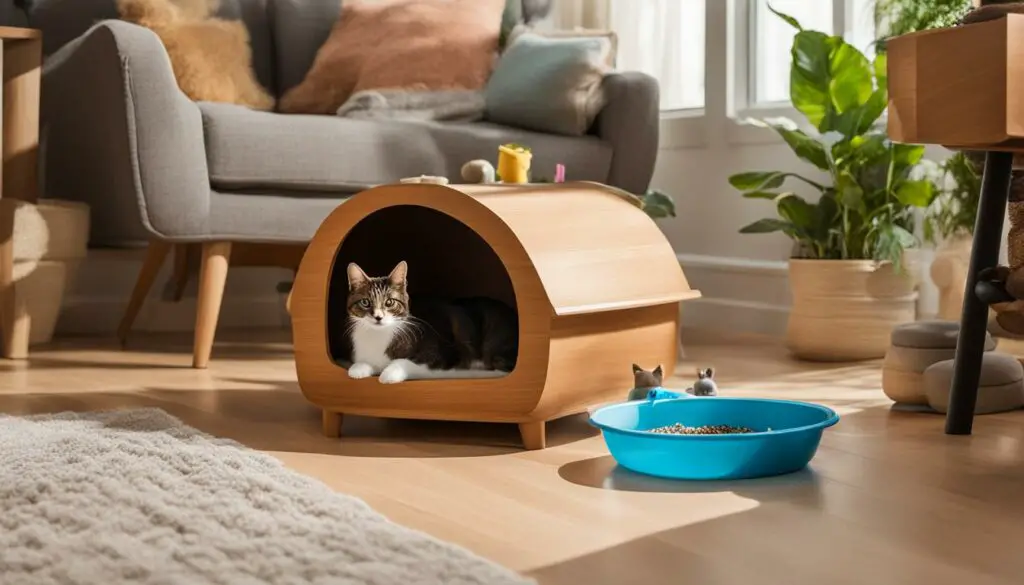
Challenges of Cat Ownership in an Apartment
Living in an apartment comes with its own set of challenges when it comes to owning a cat. The limited space and potential noise concerns require careful consideration to ensure a harmonious living environment for both you and your feline friend.
One challenge to address is the space restrictions in an apartment. Cats are naturally curious and active animals, so providing them with enough room to roam, play, and exercise is essential for their physical and mental well-being. Consider whether your apartment can accommodate cat trees, scratching posts, and other furniture that can provide vertical space for your cat to climb and explore.
Noise concerns are another aspect to take into account. Apartments can be filled with shared walls and close neighbors, so it’s important to choose a cat breed that is known for its quieter and less vocal behavior. This can help minimize disturbances for both you and your neighbors, creating a more peaceful living environment.
| Noise Behaviors | Recommended Breeds |
|---|---|
| Low vocalization | Ragdoll, British Shorthair |
| Quiet play and interaction | Persian, Russian Blue |
Scratching behavior is another consideration in an apartment setting. Cats naturally need to scratch to maintain their claws and mark their territory. To protect your furniture, provide appropriate scratching posts or boards for your cat. Place them strategically near furniture pieces that your cat may be prone to scratching, redirecting their behavior and keeping your belongings safe.
Litter box placement is crucial in an apartment to avoid any unwanted odors or mess. Find a discreet location for the litter box that is easily accessible for your cat, but also consider the airflow in your apartment to prevent smells from lingering. Regular cleaning and odor control methods can help maintain a pleasant living environment.
Cost of Cat Care
When considering getting a cat, it’s important to understand the financial responsibilities that come with cat ownership. The cost of caring for a cat can include veterinary expenses, vaccinations, regular check-ups, and preventive treatments for parasites. It’s crucial to factor in these expenses when deciding whether or not to get a cat.
Table: Comparison of Estimated Cat Care Costs
| Expense | Average Cost |
|---|---|
| Veterinary Expenses (annual) | $200 – $500 |
| Vaccinations (initial and booster shots) | $50 – $200 |
| Regular Check-ups | $50 – $100 |
| Preventive Treatments (flea, tick, heartworm) | $100 – $300 |
| Pet Insurance | $20 – $50 per month |
These estimated costs can vary depending on factors such as location, the specific needs of your cat, and the level of veterinary care you choose. It’s essential to budget for these expenses and be prepared for potential unexpected medical costs that may arise throughout your cat’s life.
Consider exploring pet insurance options to help manage the cost of cat care. Pet insurance can provide coverage for veterinary expenses, medications, and even certain procedures. It’s worth researching different plans and comparing their coverage and pricing to find the best fit for your budget and your cat’s needs.
By being aware of the financial commitments involved in cat ownership, you can make an informed decision and ensure that you can provide the necessary care and support for your feline companion.
Emotional Attachment and Interaction
When it comes to owning a cat, understanding their behavior is essential, as cats can vary in their emotional attachment and desire for human interaction. Some cats may be naturally more affectionate and seek out human company, while others may be more independent and less inclined to interact with humans. Prior to getting a cat, it’s important to consider your expectations for emotional attachment and interaction, and whether you are looking for a cat that will be a constant companion or one that appreciates their own space.
Cat behavior can be influenced by various factors, including their genetic background, early socialization experiences, and individual personality traits. While some cats may enjoy being held, cuddled, and involved in daily activities, others may prefer to observe from a distance and engage on their own terms. This individuality is what makes each cat unique and special, but it’s important to find a cat whose behavior aligns with your own preferences and lifestyle.
Creating a strong bond and emotional connection with a cat often requires patience, understanding, and respect for their boundaries. Some cats may take time to warm up to their owners and establish trust, while others may form an instant attachment. Regardless of the cat’s level of emotional attachment, it’s important to provide them with a safe and comforting environment, along with opportunities for play, interaction, and mental stimulation.

The Benefits of Interaction
Even if a cat is not overly affectionate, the interaction between a cat and their owner can still be incredibly rewarding. Cats are known for their calming presence and can provide emotional support, stress relief, and companionship. Engaging in interactive play sessions and providing mental stimulation through toys and puzzles can help strengthen the bond between you and your cat, regardless of their level of emotional attachment.
In conclusion, when considering getting a cat, it’s important to understand that not all cats will exhibit the same level of emotional attachment and desire for human interaction. Each cat is an individual with their own unique personality and preferences. By considering your own expectations and finding a cat whose behavior aligns with your lifestyle, you can form a meaningful and fulfilling relationship with your feline companion.
Cats Showing Affection
When it comes to showing affection, cats have their unique ways of expressing love and connection. Understanding these signs can deepen your bond with your feline friend and help you appreciate their affectionate gestures. Here are some common behaviors that cats display when they are feeling affectionate:
- Rubbing: Cats often rub their bodies against their owners’ legs, furniture, or other objects as a way to mark their territory and show affection. This behavior leaves behind their scent and signals that they feel safe and comfortable in their surroundings.
- Purring: One of the most well-known signs of a content and affectionate cat is purring. Cats often purr when they are feeling relaxed, happy, or seeking comfort. It’s their way of communicating their joy and affection towards their owners.
- Kneading: Have you ever noticed your cat rhythmically kneading their paws against a soft surface? This behavior, also known as “making biscuits,” is a sign of affection. It is reminiscent of the kneading motion kittens make while nursing, and it indicates that your cat feels safe and loved.
- Following: Cats that follow their owners around the house are often seeking attention and companionship. If your cat is always by your side, it’s a sign that they enjoy being in your presence and want to be a part of your daily activities.
- Grooming: Cats are known for their grooming habits, and they may extend their grooming rituals to their owners. If your cat licks you or gently grooms your hair or skin, it’s a sign of trust and affection. It’s their way of showing that you are an accepted part of their social group.
Keep in mind that each cat is unique, and their affectionate behaviors may vary. Some cats may display these signs more prominently than others, while some may have their own individual ways of showing love. Understanding and appreciating these signs can help strengthen the bond between you and your feline companion.
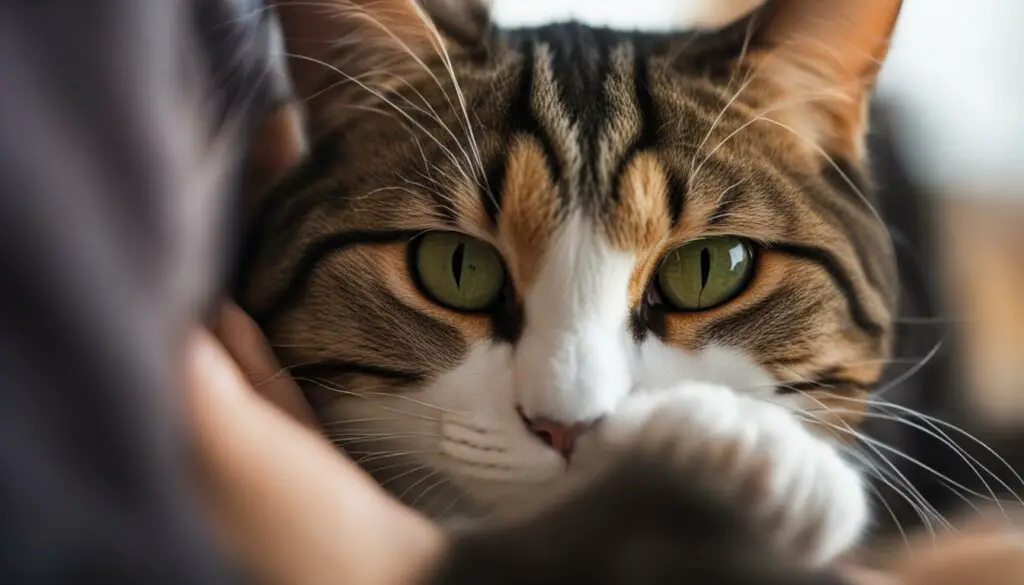
Understanding Cat Behavior
When considering cat ownership, it’s important to have a good understanding of cat behavior. Cats have natural instincts that can influence their behavior, and being aware of these instincts can help create a harmonious living environment for both the cat and the owner.
One of the most prominent instincts in cats is their territorial instinct. Cats are territorial animals and mark their territory using scent glands located on their face and paws. They may rub against furniture, walls, and even their owners to leave their scent and establish their territory. Understanding this behavior can help cat owners provide appropriate resources and spaces for their cats to feel secure and comfortable.
Cats also have hunting instincts, even if they are indoor cats. They may exhibit stalking behavior by crouching low to the ground, pouncing on objects or even imaginary prey. This behavior is a normal part of their instinctive hunting behavior and should be understood and respected by cat owners.
In addition to territorial and hunting instincts, cats may also exhibit nocturnal activity. Cats are crepuscular animals, meaning they are most active during dawn and dusk. They may engage in play, exploration, and vocalizations during these times. Understanding their natural activity patterns can help cat owners provide appropriate outlets for their cats’ energy and prevent disruptive behavior during sleeping hours.
Cats and Allergies
Allergies can be a significant concern for individuals considering getting a cat. It’s important to understand the potential challenges and explore allergy management strategies before making a decision. For those with allergies, hypoallergenic cat breeds may be a suitable option. These breeds produce fewer allergenic proteins in their saliva and skin, reducing the likelihood of triggering allergic reactions. Examples of hypoallergenic cat breeds include the Siberian, Balinese, and Russian Blue.
Allergy management is another important aspect to consider. Regular cleaning and vacuuming can help reduce the presence of allergens in the home. Additionally, keeping the cat out of the bedroom and establishing designated cat-free areas can offer relief to individuals with allergies. Consultation with an allergist or immunologist, as well as allergy testing, can provide valuable insight into specific allergens and help inform decision-making.
It’s essential to remember that even hypoallergenic cat breeds may still cause allergic reactions in some individuals. It’s recommended to spend time with cats of the desired breed to assess personal sensitivity before bringing one into the home. Taking proactive measures and understanding individual allergies can help mitigate potential risks and create a more harmonious living environment for both humans and cats.

Table: Hypoallergenic Cat Breeds
| Breed | Characteristics |
|---|---|
| Siberian | Hypoallergenic coat due to lower levels of the Fel d 1 protein |
| Balinese | Minimal shedding and reduced allergenic proteins on the coat |
| Russian Blue | Produces fewer allergenic proteins and has a dense, hypoallergenic coat |
Table source: Own research.
Disclaimer: The information provided in this table is based on general breed characteristics and may vary from individual to individual. It’s important to spend time with the specific cat of interest to assess personal sensitivity before making a decision. Consultation with professionals, such as breeders or veterinarians, is recommended to gather more specific information about hypoallergenic cat breeds.
The Benefits of Cat Ownership
While it’s important to consider the reasons why someone might not want to get a cat, it’s equally important to highlight the numerous benefits that come with cat ownership. Cats provide companionship and can become beloved members of our families. Their presence can bring comfort and joy to our lives, serving as constant sources of love and affection.
One of the notable advantages of having a cat is the stress relief they offer. Interacting with cats has been shown to lower blood pressure and reduce anxiety levels. Simply petting a cat can have a calming effect on both the mind and body, making them excellent companions for individuals seeking emotional support and relaxation.
“Cats provide companionship and can become beloved members of our families. Their presence can bring comfort and joy to our lives, serving as constant sources of love and affection.”
Furthermore, owning a cat can have positive effects on both our mental and physical health. Playing with cats can promote physical activity and exercise, helping to improve cardiovascular health and maintain a healthy weight. Additionally, cats can aid in reducing feelings of loneliness and depression, providing a sense of purpose and responsibility in our daily lives.
Lastly, cats have therapeutic effects that can benefit individuals of all ages. They are known to have a calming influence on children and can help teach them empathy and responsibility. Cats also provide comfort to the elderly, offering companionship and alleviating feelings of loneliness.
In conclusion, while cat ownership may come with its challenges, the benefits far outweigh them. From the stress relief and emotional support they offer to the positive impact they have on our mental and physical well-being, cats have a unique ability to bring joy and happiness into our lives. Whether you’re looking for a loyal companion or a furry friend to brighten your days, considering the benefits of cat ownership is essential when making the decision to bring a cat into your home.

Conclusion
After considering the various reasons to not get a cat, it’s important to approach the decision with a balanced perspective and take personal considerations into account. While cat ownership can bring companionship and provide stress relief with its therapeutic effects, it’s crucial to weigh these benefits against potential challenges.
Individuals may choose not to get a cat due to reasons such as allergies, lifestyle factors, financial considerations, and personal preferences for different levels of pet interaction and maintenance. It’s essential to prioritize one’s well-being and ensure that the decision aligns with one’s circumstances and capabilities.
By taking a thoughtful and comprehensive approach, individuals can make an informed decision that best suits their needs and preferences. Whether the choice is to become a cat owner or not, it’s important to consider the factors mentioned and approach the decision with mindfulness and empathy.
FAQ
What are some reasons to not get a cat?
Concerns about cat allergies, the maintenance of cat hair and litter boxes, the long-term commitment and responsibility of pet ownership, travel restrictions, challenges of cat ownership in an apartment living situation, the time commitment involved in caring for a cat, and the cost of care including vet visits and other expenses.
How do I find the right cat for my lifestyle?
Each cat is unique in terms of their behavior and personality, so it’s crucial to consider their individual needs and how they will fit into your home environment. It’s also important to consider the grooming needs of different cats, the importance of neutering, vaccination, and regular worming, as well as the need for regular veterinary care.
What kind of time commitment and pet maintenance does owning a cat require?
Cats need a daily care routine, including feeding, cleaning their litter box, grooming, and providing play and exercise. It’s important to consider whether you have the time and commitment to consistently provide for the needs of a cat.
Can cat allergies be a concern?
Yes, cat hair and dander can trigger allergic reactions in sensitive individuals, leading to symptoms such as itching, sneezing, and difficulty breathing. It’s important to consider whether you or someone in your household has allergies before getting a cat.
How do I maintain a litter box for a cat?
Cats require a clean and odor-free litter box, which needs to be scooped daily and fully cleaned regularly. It’s important to consider whether you are willing and able to consistently maintain a litter box for your cat.
Is owning a cat a long-term commitment?
Yes, cats can live for 15 years or longer. It’s important to consider whether you are prepared to provide care and attention to a cat throughout its entire life, including their senior years and the aging process.
What about travel restrictions with a cat?
Cats can be more difficult to accommodate for travel compared to dogs. It’s important to consider whether you have appropriate pet care arrangements for your cat when you are away, such as boarding or hiring pet sitters. Cats may also experience separation anxiety, which should be taken into account when planning for travel.
What challenges come with owning a cat in an apartment?
Owning a cat in an apartment can present unique challenges, including space restrictions, noise concerns, and the need for proper scratching areas and litter box placement in a limited space.
How much does cat care cost?
Owning a cat comes with various expenses, including veterinary care, vaccinations, regular check-ups, and preventive treatments for parasites. It’s important to consider whether you are financially prepared for the cost of cat care, including potential unexpected medical expenses. Pet insurance may also be an option to consider.
What should I consider about emotional attachment and interaction with a cat?
Cats can vary in their emotional attachment and desire for human interaction. It’s important to consider your expectations for emotional attachment and interaction with a cat before getting one.
How do cats show affection?
Cats show affection in their own unique ways, such as rubbing against their owner’s legs, purring, kneading, following them around, and grooming themselves and their owners.
What should I understand about cat behavior?
Understanding cat behavior is important when considering cat ownership. Cats have territorial instincts, hunting instincts, and may exhibit nocturnal activity. They also communicate through various vocalizations. It’s important to be aware of and comfortable with these natural behaviors.
What if I have allergies but still want to get a cat?
Individuals with allergies may need to consider hypoallergenic cat breeds or explore allergy management strategies before getting a cat. Allergy testing can help determine specific allergens and inform decision-making.
What are the benefits of cat ownership?
Cats can provide companionship, stress relief, and have positive effects on mental and physical health. These benefits should be considered alongside the potential challenges.
How do I make an informed decision about getting a cat?
When contemplating getting a cat, it’s important to have a balanced perspective and consider personal factors and preferences. The decision to not get a cat may be based on various reasons, such as allergies, lifestyle, financial considerations, and personal preferences for different levels of pet interaction and maintenance. By taking these factors into account, individuals can make an informed decision that best suits their circumstances.

